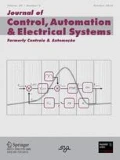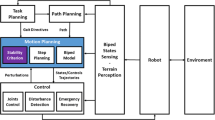Abstract
This paper develops a unified gait generation method based on discrete mechanics and nonlinear optimization technique for the compass-type biped robot on general irregular grounds. First, we derive the models of continuous-time/discrete-time compass-type biped robot (DCBR/CCBR). Next, a discrete gait generation problem on an irregular ground for the DCBR as a finite-dimensional nonlinear optimal control problem is formulated, and a solving method of it with the sequential quadratic programming is presented. Then, a transformation method of a discrete-time input into a continuous-time one is shown. Finally, some numerical simulations are illustrated to verify the effectiveness of our new approach. As a result, it is confirmed that the new method can generate stable gaits for the CCBR on various irregular grounds.











Similar content being viewed by others
References
Bloch, A. M., Leok, M., Marsden J. E., & Zenkov, D. V. (2005). Controlled Lagrangians and stabilization of the discrete cart-pendulum system. In Proceedings of 44th IEEE CDC-ECC (pp. 6579–6584). Seville.
Bloch, A. M., Leok, M., Marsden, J. E., & Zenkov, D. V. (2006). Controlled lagrangians and potential shaping for stabilization of the discrete mechanical systems. In Proceedings of 45th IEEE CDC (pp. 3333–3338) San Diego.
Collins, S. H., Ruina, A., Tedrake, R., & Wisse, M. (2005). Efficient bipedal robots based on passive-dynamic walkers. Science, 307, 1082–1085.
Erbatur, K., & Kurt, O. (2009). Natural ZMP trajectories for biped robot reference generation. IEEE Transactions on Industrial Electronics, 56(3), 835–845.
Garcia, M., Chatterjee, A., Ruina, A., & Coleman, M. J. (1998). The simplest walking model: Stability, complexity, and scaling. ASME Journal of Biomechanical Engineering, 120(2), 281–288.
Goswami, A., Espiau, B., & Keramane, A. (1997). Limit Cycles in a passive compass gait biped and passivity mimicking control laws. Autonomous Robots, 4, 273–286.
Goswami, A., Thuilot, B., & Espiau, B. (1998). A study of the passive gait of a compass-like biped robot: Symmetry and chaos. International Journal of Robotics Research, 17(12), 1282–1301.
Grizzle, J. W., Abba, G., & Plestan, F. (2001). Asymptotically stable walking for biped robots: Analysis via systems with impulse effects. IEEE Transaction on Automatic Control, 46(1), 51–64.
Gurwitz, C. B. (1989). Sequential quadratic programming methods based on approximating a projected Hessian matrix. SIAM Journal on Scientific and Statistical Computing, 10(4), 631–653.
Hass, J., Herrmann, J. M., & Geisel, T. (2006). Optimal mass distribution for passivity-based bipedal robots. International Journal of Robotics Research, 25(11), 1087–1098.
Hobbelen, D. G. E., & Wisse, M. (2008). Swing-leg retraction for limit cycle walkers improves disturbance rejection. IEEE Transactions on Robotics, 24(2), 377–389.
Huang, Q., Yokoi, K., Kajita, S., Kaneko, K., Arai, H., Koyachi, N., et al. (2001). Planning walking patterns for a biped robot. IEEE Transactions on Robotics and Automation, 17(3), 280–289.
Junge, O., Marsden, J. E., & Ober-Blöbaum, S. (2005). Discrete mechanics and optimal control. In Proceedings of 16th IFAC World Congress, Praha, Paper No. We-M14-TO/3.
Kai, T., Shintani, T. (2009). Discrete gait generation for the compass-type biped robot modeled by discrete mechanics. In Proceedings of NOLTA 2010 (pp. 434–437). Krakow.
Kai, T., Shintani, T. (2011). A gait generation method for the compass-type biped robot on slopes via discrete mechanics. In Proceedings of IEEE CDC 2011 (pp. 675–681) Orlando.
Kai, T., Shintani, T. (2011). Discrete mechanics approach to gait generation for the compass-type biped robot. In Proceedings of IFAC World Congress 2011. (pp. 434–437) Milano.
Kai, T., Shintani, T. (2012). Gait generation on periodically unlevel grounds for the compass-type biped robot via discrete mechanics. In Proceedings of IEEE MSC 2012 (pp. 1374–1381) Dubrovnik.
Kai, T. (2012). Control of the cart-pendulum system based on discrete mechanics-part I : Theoretical analysis and stabilization control. IEICE Transaction on Fundamentals of Electronics, Communications and Computer Sciences, E95–A(2), 525–533.
Kai, T., & Bito, K. (2014). A new discrete mechanics approach to swing-up control of the cart-pendulum system. Communications in Nonlinear Science and Numerical Simulation, 19, 230–244.
Kai, T., Bito, K., & Shintani, T. (2012). Control of the cart-pendulum system based on discrete mechanics-part II : Transformation to continuous-time inputs and experimental verification. IEICE Transaction on Fundamentals of Electronics, Communications and Computer Sciences, E95–A(2), 534–541.
Kane, C., Marsden, J. E., Ortiz, M., & West, M. (2000). Variational integrators and the newmark algorithm for conservative and dissipative mechanical systems. International Journal for Numerical Methods in Engineering, 49, 1295–1325.
Marsden, J. E., Patrick, G. W., & Shkoller, S. (1998). Multisymplectic geometry, variational integrators and nonlinear PDEs. Communications in Mathematical Physics, 199, 351–395.
Marsden, J. E., & West, M. (2001). Discrete mechanics and variational integrators. Acta Numerica, 10, 3571–5145.
McGeer, T. (1990). Passive Dynamic Walking. The International Journal of Robotics Research, 9(2), 62–82.
Miller, W. T. (1994). Real-time neural network control of a biped walking robot. IEEE Control Systems Magazine, 14(1), 41–48.
Morimoto, J., & Atkeson, C. G. (2007). Learning biped locomotion: Application of poincare-map-based reinforcement learning. IEEE Robotics and Automation Magazine, 14(2), 41–51.
Nakanishi, J., Morimoto, J., Endo, G., Cheng, G., Schaal, S., & Kawato, M. (2004). Learning from demonstration and adaptation of biped locomotion. Robotics and Autonomous Systems, 47, 79–91.
Nocedal, J., & Wright, S. J. (2006). Numerical optimization. Berlin: Springer.
Sardain, P., & Bessonnet, G. (2004). Forces acting on a biped robot center of pressure: zero moment point. IEEE Transactions on Systems, Man, and Cybernetics, Part A: Systems and Humans, 34(5), 630–637.
Taga, G., Yamaguchi, Y., & Shimizu, H. (1991). Self-organized control of bipedal locomotion by neural oscillators in unpredictable environment. Biological Cybernetics, 65, 147–159.
Author information
Authors and Affiliations
Corresponding author
Rights and permissions
About this article
Cite this article
Kai, T., Shibata, T. Gait Generation for the Compass-Type Biped Robot on General Irregular Grounds Via a New Blending Method of Discrete Mechanics and Nonlinear optimization. J Control Autom Electr Syst 26, 484–492 (2015). https://doi.org/10.1007/s40313-015-0192-4
Received:
Revised:
Accepted:
Published:
Issue Date:
DOI: https://doi.org/10.1007/s40313-015-0192-4




